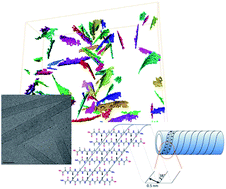Peptidenanotube formation: a crystal growth process†
Abstract
Above its critical aggregation concentration the tfa salt of the

* Corresponding authors
a Physical Chemistry, Lund University, Box 124, SE-221 00 Lund, Sweden
b Laboratory of Materials and Interface Chemistry, and Soft Matter CryoTEM Research Unit, Department of Chemical Engineering and Chemistry, Eindhoven University of Technology, PO Box 513, 5600 MB Eindhoven, The Netherlands
c Chemistry Department, Boğaziçi University, Bebek, Istanbul, Turkey
d
Department of Chemical Engineering, Yeditepe University, Istanbul, Turkey
E-mail:
seyda@yeditepe.edu.tr
Above its critical aggregation concentration the tfa salt of the

 Please wait while we load your content...
Something went wrong. Try again?
Please wait while we load your content...
Something went wrong. Try again?
Ç. Ç. Cenker, P. H. H. Bomans, H. Friedrich, B. Dedeoğlu, V. Aviyente, U. Olsson, N. A. J. M. Sommerdijk and S. Bucak, Soft Matter, 2012, 8, 7463 DOI: 10.1039/C2SM25671A
To request permission to reproduce material from this article, please go to the Copyright Clearance Center request page.
If you are an author contributing to an RSC publication, you do not need to request permission provided correct acknowledgement is given.
If you are the author of this article, you do not need to request permission to reproduce figures and diagrams provided correct acknowledgement is given. If you want to reproduce the whole article in a third-party publication (excluding your thesis/dissertation for which permission is not required) please go to the Copyright Clearance Center request page.
Read more about how to correctly acknowledge RSC content.
 Fetching data from CrossRef.
Fetching data from CrossRef.
This may take some time to load.
Loading related content
